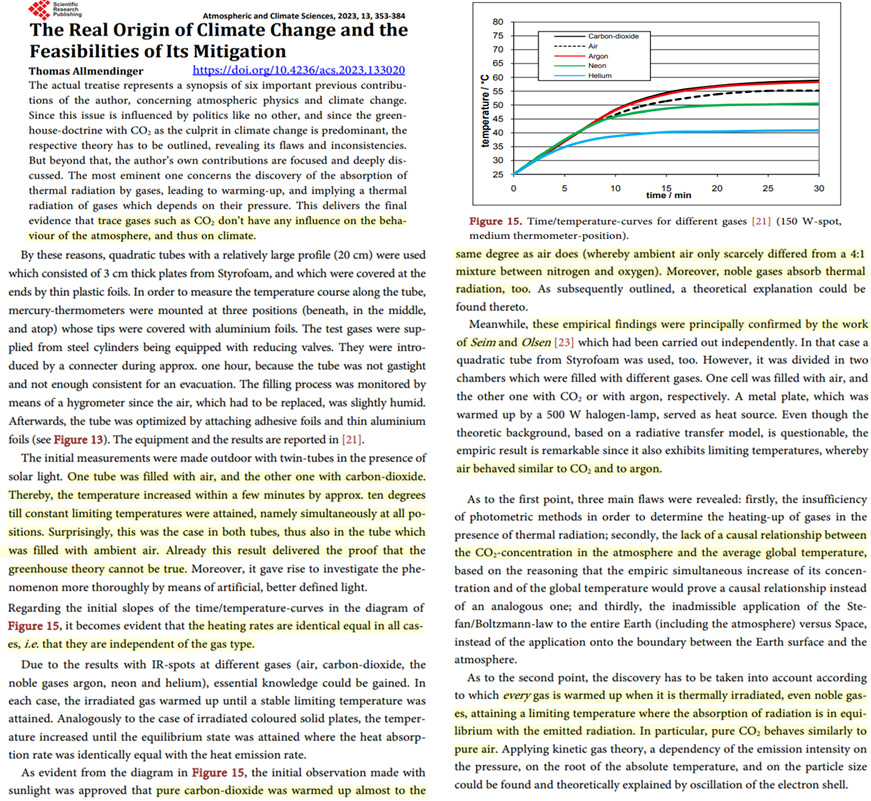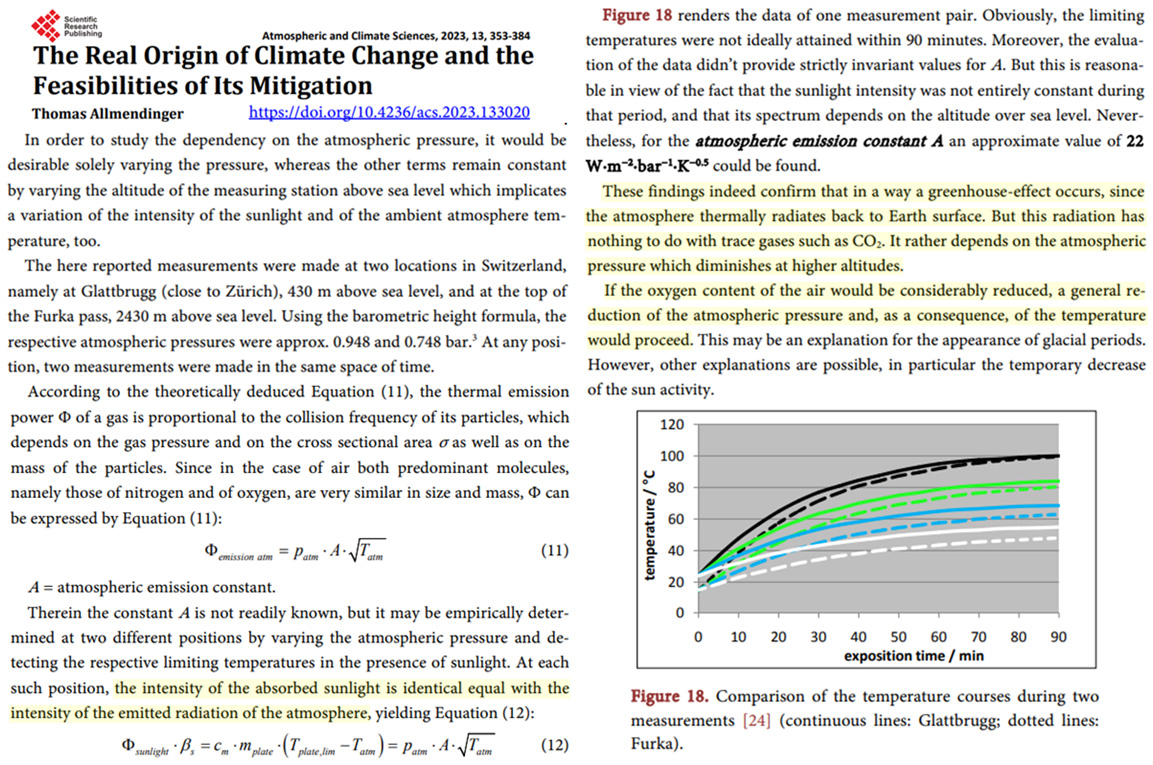Non-greenhouse gases like O2 and N2 (air) absorb radiation “almost to the same degree” as CO2 does in outdoor experiments, which is “proof that the greenhouse theory cannot be true.” – Allmendinger, 2023
A principal reason why CO2 is regarded as a special gas, the “control knob” of the globe’s surface temperature, is that it is thought to be a potent greenhouse gas that absorbs thermal radiation.
But a real-world outdoor experiment (Allmendinger, 2023) involving containers heated by sunlight reveals there is no equilibrium temperature or heating rate difference when filling a container with 100% CO2 vs. 100% argon (Ar), a non-greenhouse gas. That’s because noble gases (like Ar) absorb radiation too.
Furthermore, there is only a modest (<5%) temperature differential when the container is filled with only air (21% O2, 78% N2, 0.042% CO2) vs. a 100% (1,000,000 ppm) CO2-filled container. Like Ar, O2 and N2 are regarded as non-greenhouse gases, but they nonetheless absorb thermal radiation too.

Image Source: Allmendinger, 2023
The molecular weight of the gases, and the consequent variation in convective heat transfer, is what primarily determines the slight (<5%) temperature differential (Wagoner et al., 2010). Argon and CO2 have similar (heavier) molecular densities, allowing them to more effectively reduce heat loss, whereas as O2 and N2 are lighter gases. The radiative heat transfer properties of non-greenhouse gases vs. greenhouse gases are thus not temperature-determinative in real-world experiments.
Dr. Allmendinger conducted another outdoor experiment demonstrating the temperature gradient at different altitudes above the Earth’s surface is not determined by the radiative properties of greenhouse gases vs. non-greenhouse gases either. While the atmosphere does thermally radiate back to the Earth’s surface, “this radiation has nothing to do with trace gases such as CO2,” but instead it “depends on the atmospheric pressure which diminishes at higher altitudes.”

Image Source: Allmendinger, 2023
Thus, it can be empirically demonstrated that “trace gases such as CO2 don’t have any influence on the behavior of the atmosphere, and thus on climate.”





Allmendinger (2023) is wrong.
GHGs are gases which are radiatively active in the far (LW) IR, below about 4 µm. They are all triatomic (or greater), with bending modes which correspond to the energies of those long wavelength photons. Monatomic Ar and diatomic N2 & O2 don’t have bending modes, so they’re transparent to those wavelengths.
GHGs help warm the Earth by absorbing LW IR radiation emitted by the Earth, which otherwise would have escaped to space. By absorbing that energy, GHGs warm the atmosphere. (For very sparse/minor GHGs, that’s a pretty complete description of how they work, but for major GHGs like CO2, it’s more complicated, because there’s a lot of reabsorption & readmission going on.)
You might think that absorbing all that outgoing LW IR would make GHG molecules hotter than the N2, O2 & Ar in the atmosphere. That would be true, were it not for the fact that the air molecules are continually colliding with one another. Those collisions cause continual and and rapid exchanges of kinetic/thermal energy (heat content) among the various gases in the atmosphere, keeping them all in near perfect thermal equilibrium.
So the GHGs act as dyes (colorants) of the atmosphere, tinting it in the far IR. It really doesn’t matter which GHG molecule absorbs a photon, its energy ends up just fractionally warming the bulk atmosphere.
Here are some good resources for learning more about it:
https://sealevel.info/learnmore.html?0=physics#physics
I especially recommend the 2014 UNC Physics Colloquium by Princeton atmospheric physicist Will Happer, and this follow-up discussion:
https://sealevel.info/Happer_UNC_2014-09-08/Another_question.html
“Filling a container with 100% CO2 vs. 100% argon” obviously cannot detect that effect, but a spectrophotometer aimed at the Earth from orbit can. Note the big “notch” (which I annotated in green) around 15 µm. That’s the effect of CO2 in the atmosphere, absorbing (blocking) outbound longwave IR radiation, and thus warming the air.
[…] No Trick Zone […]
A few years back the BBC televised an experiment in a test tube to illustrate that CO2 causes warming – a few years later the experiment was repeated by scientists using Argon- not a greenhouse gas- the results with Argon were the same as CO2-
https://rtobin.phy.tufts.edu/Wagoner%20AJP%202010.pdf
P.S. – Note that the publisher of this paper is one of the most notorious predatory publishers:
https://scholarlyoa.com/the-chinese-publisher-scirp-scientific-research-publishing-a-publishing-empire-built-on-junk-science/
https://predatoryreports.org/news/f/is-scientific-research-publishing-scirp-a-predatory-publisher
https://web.archive.org/web/20170112125427/https://scholarlyoa.com/publishers/#:~:text=SCIRP
Of course this journal is not indexed by DOAJ:
https://doaj.org/search/journals?ref=homepage-box&source=%7B%22query%22%3A%7B%22query_string%22%3A%7B%22query%22%3A%22Atmospheric%20and%20Climate%20Sciences%22%2C%22default_operator%22%3A%22AND%22%7D%7D%2C%22track_total_hits%22%3Atrue%7D
For a fee of $899 they’ll publish any garbage.
BTW, this is the graph of Earth’s emission spectrum, showing the big (green) notch, due to LW IR absorption by CO2:
https://sealevel.info/slide16_excerpt2_FTIR_data_from_a_satellite_tropical_western_pacific_annot12.png
[…] blog of the day is No Tricks Zone, with a post on real world evidence showing CO2 is not the control […]
[…] – More Real-World Evidence Indicates ‘Trace Gases Such As CO2 Don’t Have Any Influence…On Climat… […]
Whatever is, or isn’t a GHG and whatever is or isn’t the cause of ecological collapse it is clear the planet has moved on from the ‘Goldilocks’ supporter of life to one that will not do so for very much longer. Human life is much more vulnerable than others.